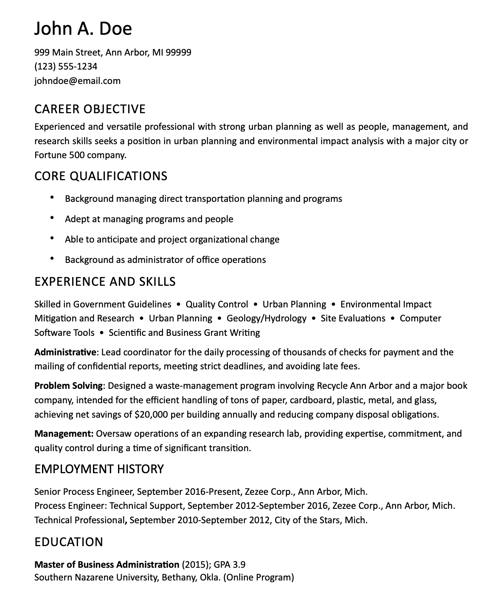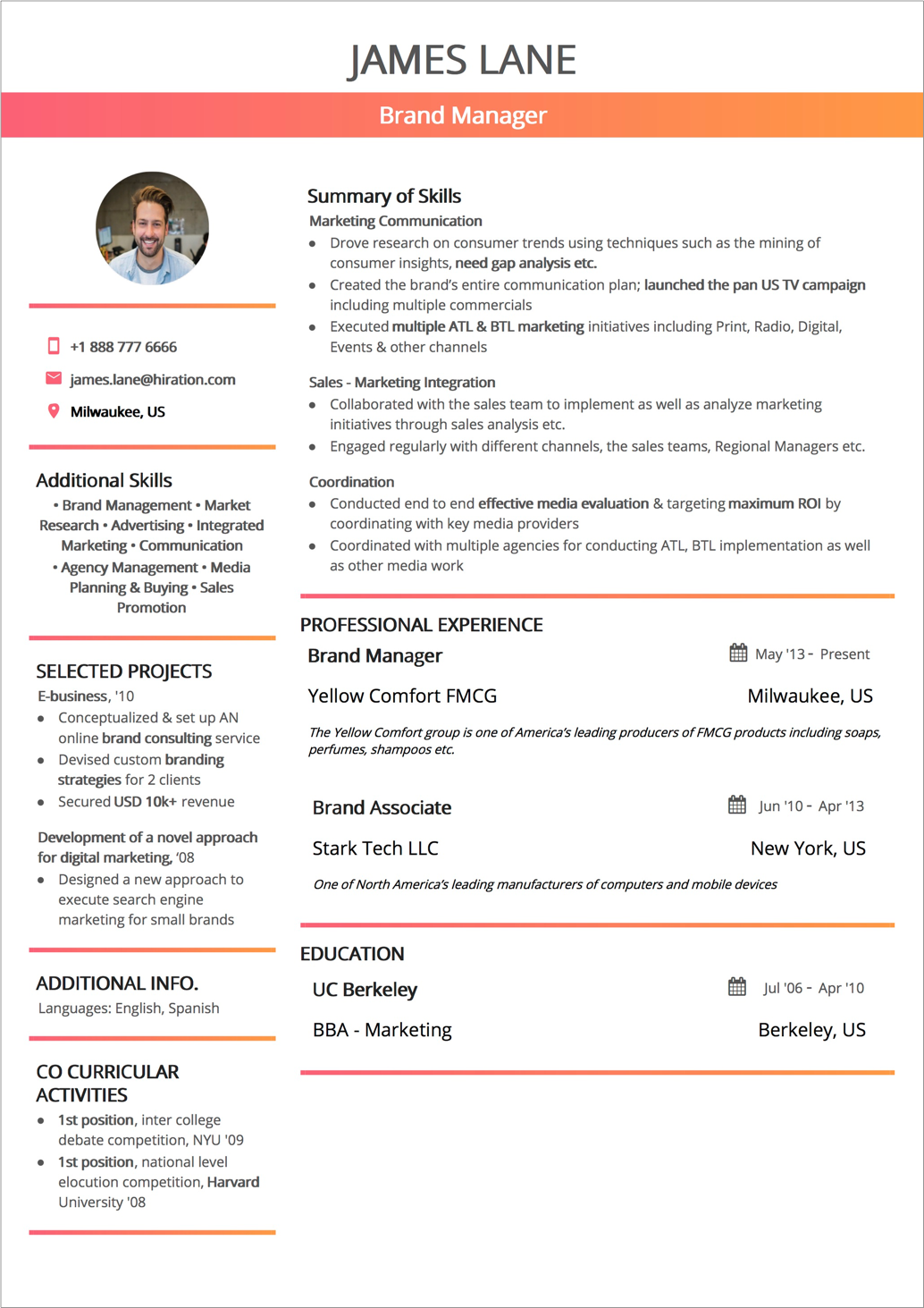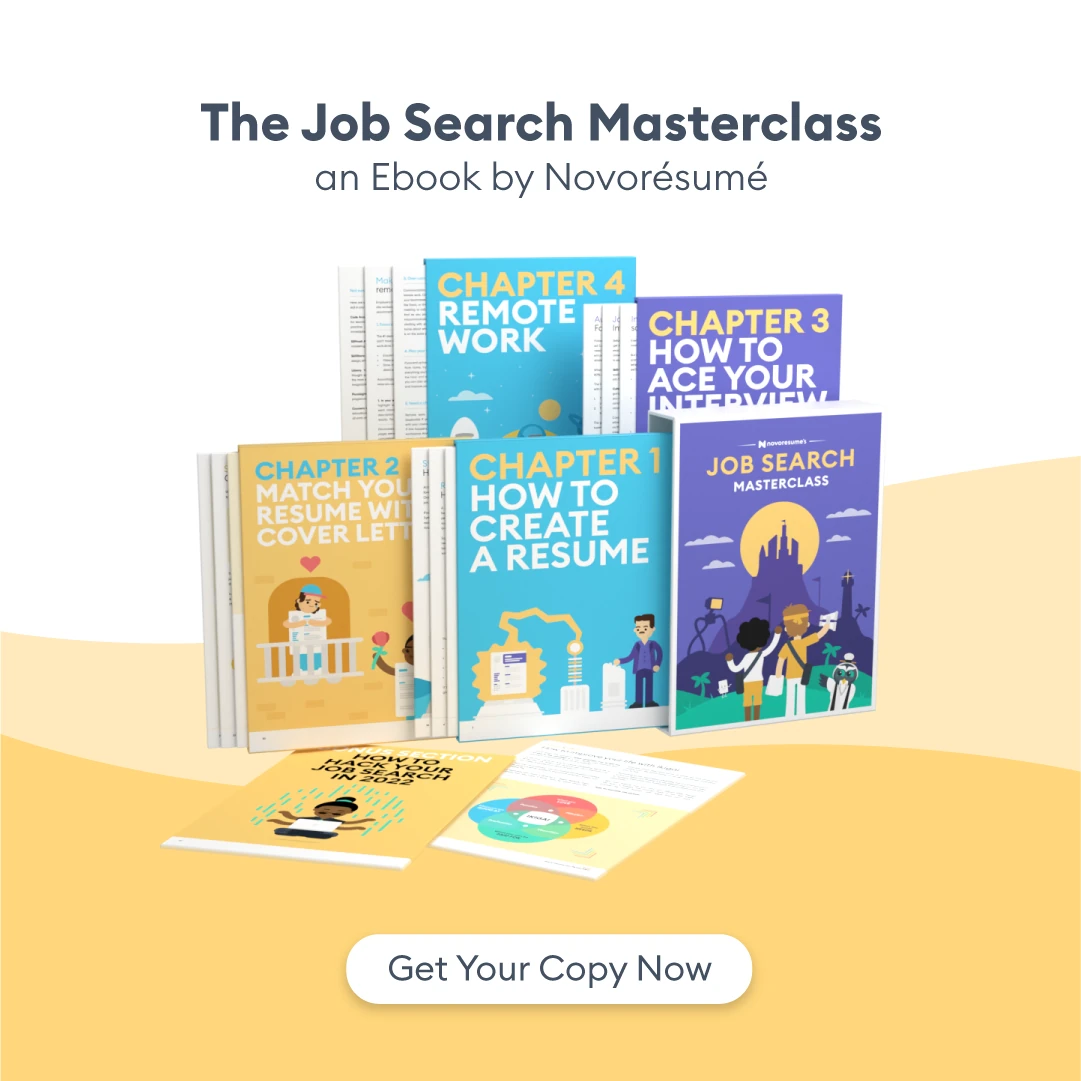Everything You Need to Know About Functional Resumes
Published: June 21, 2023
Not sure how to make your resume really pop? Wondering how to highlight your skills and experience, despite any possible gaps? You might benefit from a functional resume.

Luckily, this article closely examines everything you need to know about functional resumes, including what they are, when to use them, and the benefits they offer.
So, whether you’re new in the workforce, changing careers, or have experienced some time unemployed, a functional resume can help you attract potential employers.

What is a functional resume?
The benefits of functional resumes, when to use a functional resume, limitations of functional resumes, how to write a functional resume, functional resume examples.
Unlike a traditional, chronological resume, a functional resume focuses on your skills and experience — not just your work history.
So, instead of focusing on companies, roles, and dates of employment, it groups things like your marketing experience together, presenting a collection of relevant experiences and skills.
It’s great if you’re changing careers or have a gap in your work history, as it steers attention away from dates and underscores why you’re a great fit for the role.
Plus, functional resumes begin with an objective or summary statement that sets the tone. Then it highlights your skills, accomplishments, and education.
The result is a much more targeted, customized resume that reflects your strengths and qualifications.
It’s probably clear right now — functional resumes are pretty great. Still, this deserves to be broken down into specifics. Here are the four main, undeniable advantages of functional resumes:
1. Highlights relevant skills and accomplishments.
When applying for a job, a functional resume highlights skills and accomplishments related to the position. It emphasizes your most relevant skills, even if they weren't acquired in a traditional workplace.
2. Overcomes employment gaps.
Another benefit of a functional resume is that it can help overcome employment gaps.
So, for instance, if you’ve taken time off or had a period of unemployment, a functional resume leads with the good, so the gap isn’t as much of a heavy hitter.
3. Allows for flexibility.
You can also present your qualifications in a more flexible way with a functional resume. For example, you can group your skills and accomplishments under specific headings, like "project management" or "leadership experience.”
It makes it easier for employers to find the relevant bits they’re looking for quickly.
4. Stands out from the crowd.
Here’s something else a functional resume can do better than the rest: help you stand out. It’s easy to do when basically everyone else is using the standard one.
So with a functional resume, you can show that you’re not only willing to try different, innovative approaches but also that you can think creatively.
A functional resume is great if you’re looking for a way to underscore skills and accomplishments in a tailored way that fits the role you’re applying for.
It considers everything you’ve learned, even in non-traditional formats, making it a genius solution if you have employment gaps.
A functional resume may be right for you if you fit into any of these categories:
- When you have limited work experience. A functional resume can help you highlight your relevant skills and accomplishments if you're a recent graduate or have limited work experience in your field.
- When changing careers. A functional resume can help you showcase your transferrable skills that can apply to your new career path if you're changing careers.
- When returning to the workforce. A functional resume emphasizes your skills and experience rather than just your work history.
- When job requirements are specific. A functional resume can help you highlight specific qualifications and skills clearly and concisely from a job posting.
A functional resume highlights your relevant skills, accomplishments, and experiences — even with a limited work history. However, pay close attention to the roles you’re applying for.
Functional resumes only work for some applications, so make sure you research the company first before deciding which type of resume to use. Here are three instances where you might want to skip using a functional resume.
Sizable Work History
Some people are just super lucky — and you might be one of them. If you’ve been working consistently in your field, with role after role of relevant jobs and experience building, then you’re better off using a chronological resume.
You have the dates, roles, and skills to showcase. You don’t need a functional resume to help you fill in any gaps.
ATS Compatibility
With the sheer amount of resumes floating around out there, it’s no wonder some companies use Applicant Tracking Systems (ATS) to filter candidates. However, ATS doesn’t play nice with resumes that don't follow a traditional structure.
So, even if you’re more than qualified for a role, the recruiters might never see your resume.
Employer Preferences
Also, keep in mind employer or industry preferences. Some hiring managers prefer traditional resumes, so using a functional format may hurt your chances.
Before deciding which format to use, research the company and job posting. It’ll help you tailor your resume to meet their expectations and present you in the best possible light.
If you've decided that a functional resume is the best choice for your situation, here's a step-by-step guide to help you create one.
1. Start with a strong summary statement.
Start your resume on the right foot with a summary statement showcasing your skills, qualifications, and experience.
It's important to customize this section to the specific job you're applying for so that it provides a brief overview of why you're a great fit for the position. This statement should capture the hiring manager's attention and entice them to continue reading your resume.
2. Identify your key skills.
Once you finish that, the next step is to list the skills you want to emphasize in your resume. This section should showcase your technical and soft skills that are relevant to the job you're applying for.
Demonstrating how you have applied these skills in the past helps the hiring manager understand your skills. So highlight your key strengths — it’ll help you show why you’re the best candidate for the job.
3. Organize your skills into sections.
After identifying your top skills, organize them into clear sections that make sense for your work history and your desired job.
For example, you could divide your skills into Technical Skills, Leadership Experience, or Project Management Skills sections. This allows the hiring manager to quickly and easily identify the areas where you excel and can help you stand out as a highly qualified candidate.
4. Provide supporting examples.
When detailing your skills within each section of the resume, provide concrete examples of how you've applied those skills in real-life situations.
Include specific projects you’ve worked on, notable achievements you've accomplished, or other relevant experiences that demonstrate your proficiency in that particular skill.
5. Include your work history.
Even though a functional resume may not focus heavily on your work history, providing a brief overview of your employment background is necessary.
You should list your job titles, the names of the companies you worked for, the dates of employment, and a concise description of your responsibilities and notable achievements in each position.
6. Tailor your resume to the job posting.
Ultimately, it's essential to customize your functional resume to the specific job. So brush up on the role, company, and industry.
Then use your research to adjust your summary statement, reorder your skill sections, or incorporate different examples that emphasize the most relevant experiences for each position.
By tailoring your resume to the job posting, you can improve your chances of capturing the attention of hiring managers and securing an interview.
Here are three functional resume templates to give you an idea of what your own resume could look like.
The Blended Resume

Don't forget to share this post!
Related articles.
![do functional resumes really work 27 of the Best Professional Bio Examples I've Ever Seen [+ Templates]](https://blog.hubspot.com/hubfs/Untitled%20design%20%2863%29.jpg)
27 of the Best Professional Bio Examples I've Ever Seen [+ Templates]

Portfolios vs. Resumes — The Complete Guide

40 Interests That Deserve a Place on Your Resume

Making the Most of Electronic Resumes (Pro Tips and Tricks)

How to Write a Simple, Effective Resume (+20 Examples)

How to Write the Perfect Project Manager Resume
![do functional resumes really work 27 of the Best Professional Bio Examples We've Ever Seen [+ Templates]](https://blog.hubspot.com/hubfs/professional-bio-examples-4.webp)
27 of the Best Professional Bio Examples We've Ever Seen [+ Templates]

31 Free Resume Templates for Microsoft Word (& How to Make Your Own)

How to Write the Perfect Resume for Internships

Maximize Your Impact: 205 Action Verbs to Use on Your Resume
Resume templates to create a killer resume for your job application.
Marketing software that helps you drive revenue, save time and resources, and measure and optimize your investments — all on one easy-to-use platform
- Knowledge Base
- Free Resume Templates
- Resume Builder
- Resume Examples
- Free Resume Review
Click here to directly go to the complete Functional resume sample.
What is a functional resume?
It is a resume format used by professionals who want to highlight their skills over experience.
Before we dive-deeper into the use and meaning of a functional resume, we need to understand the types of resume formats available to us.
There are 3 standard resume formats used by professionals from different industries. This blog will help you understand how and when to choose a functional resume for your job application.
The following questions will be answered in the article:
- What is a Functional Resume Template?
- Difference between Chronological vs Functional Resume
- Why do we use a Functional Resume Template?
- Pros & cons of functional and chronological resume formats
- Who should use a Functional Resume Template?
- How to make a Functional Resume?
- How to structure a Functional Resume Template?
- Tips to write a Functional Resume
Types of Resume Format
There are three different types of resumes that are accepted within the industry. These resume templates are:
Reverse Chronological Resume Layout
In which your information starts from your current/last-held profile and dates back to the beginning of your education. It includes all your major achievements and information listed along with important dates.
The resume template examples follow the below-mentioned structure:
- Contact information
- Resume summary or resume objective
- Work experience
- Additional Sections
Combination Resume Layout
It is a combination of the reverse chronological resume format and the functional resume format. It allows a candidate to showcase their skills and achievements with evidence from their professional experience.
The points on this format of the resume are grouped based on the skills highlighted.
The resume template examples follow:
- Skills Summary
- Additional Skills
- Work Experience
What Is a Functional Resume Template?
Functional resumes are essentially skill based resumes, wherein professionals expand and highlight their relevant skills rather than their work experience.
This format is recommended by resume experts for people with gaps in their employment history or for ones who have changed their jobs a lot.
To help you understand better, here are a few pointer about functional resume:
- It focuses on your skill set rather than your work experience
- It works best for when your work history is not related to your targeted job
- It works in favor for professionals with gaps in their employment history or those who have frequently changed jobs
The ideal structure of the resume template is:
- Resume objective
Also Read: What is the best type of resume format?
Functional Resume vs Chronological Resume
Functional resume template: why do we use it.
People who benefit from a functional resume are:
- Professionals joining creative industries - because your portfolio matters more than your resume.
- Professionals transitioning Industry - as a detailed job descriptions could be too difficult for unfamiliar recruiters to comprehend.
- Overqualified or Under-qualified Candidates - who are joining mid-level jobs.
A few key points about the functional resume format:
- The functional resume can be used by candidates to focus on skills and avoid the work history.
- Since the focus is on the skills, it helps mask the job shifting trait of the candidate.
- The functional resume format is not parsed by most ATS since the ATS only looks for points under the relevant work experience.
- The functional format is not a well accepted resume format as it raises suspicions in the minds of the recruiters that the candidate is trying to hide something.
Functional Resume Template: Who Should Use It and When?
A functional resume template is particularly useful for job-seekers who:
- Have frequently changed jobs
- Have gaps in their work history
- Are reentering the workforce
- Are transitioning into new careers
- Under-qualified or Overqualified for particular job posts
The reason functional resumes work well for these people is that most of our acquired skills are transferable despite our careers not standing well.
For example , if you have been a sales manager, you were possibly responsible for training, coaching, and customer relations. These skills could even be used in your functional resume for a Public Relations Manager.
In a chronological resume , this information might not appeal to a recruiter. Essentially you did not hold the title of Public Relations Manager. However, the functional resume format showcases that despite your job profile you have dealt with PR-related issues.
Eventually it comes to how you illustrate yourself. If you give the employers the same information in an improved package you are bound to increase your chances for an interviews. Functional resumes describes more than just background and experience.
How to Make a Functional Resume?
Before we move on to making a functional resume, first we need to understand the format of a functional resume.
How to Format a Functional Resume?
- Strategically group your key skills into different categories
- Keep the employment section brief
- List your previous designations along with the company in your employment section
- You can omit selective information due to non-compliance with the target profile
Structure of a Functional Resume Format
Follow the order given below to make your resume using the Functional Format:
Contact Information
- Qualifications Summary
- Relevant Skills
- Professional Experience (dates optional)
- The Additional Section
Key Sections In a Functional Resume
Functional resume summary.
Here are a few pointers to keep in mind while drafting a functional format summary:
- Spend maximum time on crafting your functional resume summary
- It should be the last section that you write in your resume
- Highlight your key skills and achievements that align with your target profile
- Limit your summary to 3-4 lines
- Avoid writing boring and elaborate summary, keep it concise and relevant
Also Read : How to write a resume summary
In functional resumes, the candidate’s skills are more important than their work history.
The skills section in a functional resume template should include at least three skills that are significant to the target job. For each skill, group 3 or 4 points which can provide evidence for the same.
Quantifying your skills in your functional resume instills confidence in the employer. It showcases that you are able to fulfill the requirements of the position.
In a functional resume template, skills come after your personal details and before your professional or academic experience. To best highlight your functional resume skills list ensure a combination of
- Skills listed in the job description
- Skills you possess
Although adding your contact information looks like the easiest part of the resume writing process yet many functional resumes manage to miss relevant contact details. Include your:
- Phone number
- E-mail address
- Home address (city and state)
You may even include your LinkedIn URL but do not redirect the recruiter to an empty profile.
Your name should ideally be the largest text on the page between 20-24 pt. font size. The rest of your font may correspond to the font style and size of the rest of the page.
Professional Experience
In functional resumes, the professional experience section showcases your experience without prominent display. This shifts the focus on the skills and other qualifications you have for the position.
To conceal your missing work experiences:
Label your period of unemployment
You may have been unemployed for legitimate reasons like being a parent or doing an independent study or being a full-time student. You may describe yourself in the following ways to label your period of unemployment:
- Full-Time Student
- Independent Study
- Full-Time Parent
- Family Management
- Adventure Travel
- Personal Travel
You must always demonstrate on your functional resume that you were doing something during your gaps in employment. Refrain from explaining them as a result of:
- Rehabilitation, or
Refrain from specific dates
In the functional resume examples you might notice minimal mention of the periods of employment. This creates the impression that even if you were unemployed during the middle of the year 2010, it appears as though you have been consistently working.
This is an acceptable way of “fudging” in functional resumes.
Drafting the education section of functional resume is similar to reverse chronological format resume.
- Include the name of the university along with the location
- Name of the course along with the GPA
- Date of enrollment and graduation
However, if your educational experience corresponds to the job you are applying for then you must mention the skills you have acquired in due process.
In case your degree is not relevant to your field, keep this section short. You may also consider changing the headline to "Training and Education" to incorporate more volume of relevant skills.
Functional Resume Format Template Sample
An example of a free functional resume sample template is attached for a better understanding of how you can proceed with writing your resume.

Tips for Crafting a Functional Resume
- Employ professional or sans-serif fonts such as, Arial, Verdana, Trebuchet MS, Century Gothic, Calibri, Lucida Sans, Tahoma, etc. over serif fonts
- Maintain the font size larger than 10 pts. but smaller than 12 pts. for the section points
- Maintain the font size larger than 12 pts. but smaller than 14 pts. for the section headings
- Stick to the same date format. The standard date format in functional resumes is (mm/yy)
- Follow the current trends. Resume examples 2019 may differ from resume examples 2022
- Refrain from cramming your resume with gimmicky graphics
- Leave more white space for your recruiters to have a comfortable read
- Do not include pictures in your functional resumes
- Do not try to fit every important information on a one-page resume. Do not, however, exclude key details about your career
Functional Resume or Chronological Resume: Which Should You Use?
Pros & cons of using a reverse chronological resumes.
Pros of using a reverse chronological resume
- It provides a clear view of your career trajectory
- This format is widely accepted by recruiters
- It works in your favor if you have an extensive work history related to your targeted job
Cons of using a reverse chronological format
- It highlights your career gaps in your resume
- Showcases unrelated work to your targeted job
Pros & Cons of Using Functional Resumes
Pros of using a functional resume format
- It helps in hiding career gaps in employment history
- It is advantageous for fresher who have no work experience
- It is the best choice for professionals changing their career trajectory
Cons of using a functional resume format
- It send a message to the recruiters that you are hiding something
- It is not ATS compliant
- It doesn't cover your entire work history
Why do Recruiters Dislike this Format?
Recruiters usually skip to the work history to figure out what you might be hiding. In the process, if you manage to impress with your skills, you are good to go.
- Within the context of skills and accomplishments, it gives you a better opportunity to make yourself stand out despite having significant experiences.
- Recruiters are familiar with that fact that the functional resume format covers gaps in the applicant’s experience.
Use with Caution
Although a functional resume might sound like it could suit your situation yet you must be conscious of the few drawbacks to this approach.
Excluding the dates or titles can raise the recruiter's suspicions that you might be trying to hide something.
It can be frustrating for recruiters to figure out where you performed a particular accomplishment.
So carefully evaluate your situation, weigh the pros and cons and if you consider the functional resume template an the advantage which outweighs the drawbacks you may go ahead with it. The skills-based resume could present you in the best light.
Key Takeaways
- It is critical to choose the best resume format for the job application. The best best format should ideally employ all the necessary keywords .
- Picking a proper format ensures focusing on either of the two - your skills or your career progression
- Make sure that your resume format do not make your recruiters suspicious of your achievements.
- Your resume format should address two points - how well you can you do the job and If you the company can work with you?
- Opt for a functional resume template if you have frequently changed jobs or have gaps in their work history
- Quantify your work experiences with your achievements using the Cause Effect formula
- Write a strong skills section and boast any certifications or awards you have received
Hiration does not recommend the use of functional resumes.
Go to Hiration's career platform which has 24/7 chat support and get professional assistance with all your job & career-related queries.
You can also write to us at [email protected] .

Share this blog
Subscribe to Free Resume Writing Blog by Hiration
Get the latest posts delivered right to your inbox
Stay up to date! Get all the latest & greatest posts delivered straight to your inbox
Is Your Resume ATS Friendly To Get Shortlisted?
Upload your resume for a free expert review.

The Functional Resume: What It Is & When To Use It (Spoiler: Never)

3 key takeaways
- What a functional resume is
- How using this resume format might put you at a disadvantage
- How to use Teal's resume templates (+ functional resume examples)
Considering a functional resume format because your skills outweigh your work experience?
A functional resume focuses on specific skills rather than roles and companies—moving away from a traditional or chronological resume layout. And while it sounds like a good strategy if you're looking to highlight certain abilities, using a functional resume still requires some consideration.
What is a functional resume?
A functional resume (sometimes called a skills-based resume format) focuses on the skills that qualify you for a role. This resume format prioritizes the tools and aptitudes you've used to do the job over where and when you've done it.

Teal Note: We can provide guidance for building a functional resume, but this resume template doesn't exist in the Teal platform.
As the workforce evolves, functional resumes have become increasingly popular—but not universally accepted; the trend toward functional resumes is more prevalent among job seekers than hiring professionals. Here's why:
By emphasizing transferable skills and abilities, a functional resume allows anyone with a non-linear career path or limited work experience to present areas of strengths and potential rather than a job history.
But while the core of a functional resume emphasizes skills and competencies, it doesn't focus on:
- Comprehensive work history
Recruiting expert and Teal Social Media Manager Leah Dillon says:
"Anyone can list a skill, but just listing it doesn’t add value. It’s about showcasing that skill through experience, whether at a company or independently: How do you know it? How did you use it to have an impact alongside other skills?"
The elements above are critical for hiring professionals to assess your qualifications, especially during the initial screening. Direct, relevant experience, reflected through a clear timeline and job titles, is crucial to many job requirements.
Dillon echos this sentiment:
"Companies are looking for people to help drive the business forward, and those who showcase they’ve helped drive initiatives along tend to have higher interview rates."
Disadvantages of a functional resume
- Lack of familiarity: Recruiters may find a functional resume less intuitive, making it harder to extract critical information quickly.
- Potential for skepticism: The absence of a chronological work history can look like an attempt to hide gaps in employment or a lack of specific experience.
- Difficulty establishing career progression: Demonstrating professional growth over time is often key to emphasizing the evolution of roles and responsibilities.
- Limited skills showcase: Functional resumes miss the opportunity to show the breadth of your abilities. A range of skills throughout your resume will help align your experience with a job's requirements. Merely listing skills without showing how they've been applied collectively to have an impact undermines the effectiveness of your entire resume.
Functional resumes vs. other resume formats
Chronological resume.
A chronological resume (or reverse-chronological resume ) is the most widely accepted resume format—presenting your work history in reverse chronological order.
It offers a straightforward view of your career progression, highlighting your work experience and making it easy for hiring managers and recruiters to see your background, achievements, and how you've used your skills to have an impact over time.

View our full selection of free reverse-chronological resume templates to find a style and presentation that suits your career.
Combination resume
The combination resume , or hybrid, blends elements of both functional and chronological resumes while still offering a clear and easy-to-read layout. It typically starts with a professional summary, followed by a section for hard or technical skills, and then a reverse chronological listing of your work history.

When to use a functional resume
If you've made it this far and still feel the best resume format is a skills-based resume, here are the best use cases.
Career pivoters
Suppose you're transitioning to a new industry or career path. In that case, a functional resume can help highlight transferable skills relevant to your new field—regardless of where you've acquired them.
Those with employment gaps
If you have a gap in your employment, you can use a functional resume to emphasize your skills, highlighting what you bring to the table rather than focusing on your employment history.
Reentering the workforce
If you're returning to work after a significant break, a functional resume can help you highlight your relevant, valuable skills.
First-time job seekers
If you're a job seeker creating a resume with no work experience , a functional resume format focuses on skills rather than a non-existent or thin work history.
For applications that request this format
Some job postings might request a functional resume. In these cases, sticking to this format shows you can follow directions and understand the specific preferences of your prospective employer.
How to write a functional resume
Before you choose a resume format, you need the right tool to store your skills, achievements, and more.
The Teal AI Resume Builder is a free platform to house all these details in one central location.

Now, it's time to write your functional resume.
1. Start with your contact information
You want prospective employers to contact you, so you're going to need to give them those details as clearly as possible.
Your resume contact information should include:
- Phone Number
- Professional email address
- LinkedIn profile URL
- Portfolio or personal website URL (if applicable)
- Your target title
2. Add a professional summary
Below your contact information, write a 3-5 sentence professional summary. Consider this your highlight reel—zeroing in on top achievements, skills, and qualifications while generating enough interest to keep the hiring manager or recruiter reading the rest of your resume.
Pro Tip: If you want to save time writing your professional summary, try Teal’s AI Summary Generator to write tailored, position-specific summaries in seconds.
3. List relevant skills
Next up, list your skills. Because you're using a functional resume format, this section will change each time you apply for a specific role.
The skills in your resume (regardless of format) should always align with the job description of the role you're applying to.
Resume skills example:
If a job description says,
"3 years of experience in an SEO, Growth Ops, or Marketing Ops role, ideally in a startup environment for a B2C audience with strong knowledge building and owning workflows as it relates to SEO, content production, and publishing."
Then, your resume's "Skill" section should focus on at least three skills listed.
- Content Production
Not sure which skills matter most? Teal's got you covered. The Teal AI Resume Builder pulls the top skills as keywords from any job description, so you know which ones matter most.

Once you've identified the top three skills in the job description, add three to five bullet points beneath each to showcase how you used that skill to have impact.
Using the job description above, here's a functional resume example of how this might look.
- Orchestrated a growth ops strategy, successfully improving SEO workflow efficiency by 25%
- Led a team in implementing growth op practices, increasing web traffic by 35%
- Redesigned growth op workflows, improving content production and publishing by 20%
4. Add optional sections
Once you have your primary skills and the impact of those skills, add job history, an "Education" section, and certifications to support them.
4 tips for writing a functional resume
Now that you understand how to write a functional resume let's go over some best practices that'll help guide you.
- Only emphasize relevant skills : Identify the skills most relevant to the job you’re applying for and provide specific examples of how you used those skills.
- Quantify your achievements : Wherever possible, use numbers, metrics, and data to show the impact of your work. Think efficiency improvements, revenue growth, etc.
- Use a clear, organized layout : Ensure your resume is easy to read. Use headings, bullet points, and consistent formatting to make your skills and achievements stand out.
- Tailor your resume : Customize your target title, resume summary, skills, and bullet points—ensuring your content aligns with what an employer is looking for.
Functional resume format
The functional resume layout differs significantly from other traditional formats. Here's how to do it:
- Contact details
- Your resume summary
- A clear "Skills" section with achievements relevant to the role
If you include an employment history, place it after the skills section. Education and any other relevant details (certifications or volunteer experience) should come last.
3 tips for formatting a functional resume
- Provide clarity: Use a clean, easy-to-read layout. Opt for bullet points to describe your skills and achievements, making the resume scannable.
- Use consistent formatting : Your resume content should stick to one font style and size, with clear and slightly larger or bolded headings to distinguish each section.
- Balance white space and text: A well-balanced layout avoids clutter, making your resume clear and easy to read.
Functional resume examples
A functional resume example can help guide your process—giving you a clear idea of how to create a compelling functional resume.
Data analyst functional resume example

Software engineer skills-based resume sample

Project manager functional resume example

Functional resume templates
A free functional resume template can be a valuable tool in writing your resume.
Functional resume templates provide a structured layout so you can effectively showcase your skills and their impact.
Websites like Teal, Canva, Google, and Microsoft offer a variety of resume templates . These platforms are user-friendly, and the templates cater to different career needs and styles.
How to use skills-based resume templates
1. Copy the template into your editing software : Copy and paste (or download the template) in your preferred editing software.

2. Customize each section : Replace any placeholder text with your own details. Focus heavily on the skills section, making sure to highlight only skills that are 100% relevant to the job you're applying for.

3. Adjust the design : While the template provides a basic structure, feel free to make minor adjustments to the design. (This could include changing font sizes or styles, adjusting the layout of sections, or adding a small pop of color. Just be mindful to keep it easy to read.)

4. Proofread and edit : Make sure your resume is free of errors like placeholder text and the information is current and accurate.

Skills-based resume templates
Below are some free skills-based resume templates that provide a solid foundation for you to start from. Use them as a guide for showcasing your unique skills and experiences effectively.
Student skills-based resume template
[Full Name]
[Contact Information]
[Target Title]
Professional Summary
[Highly motivated and detail-oriented student] pursuing a [Bachelor's/Master's] degree in [Field of Study] with a strong foundation in [Key Skills]. Experienced in [mention any relevant internships, part-time jobs, or projects with impact] and passionate about [specific interest within the field].
[Relevant Skill]
- Achievement with impact
[Bachelor's/Master's] in [Field of Study]
[University Name], [Expected Year of Graduation]
Coursework (Optional)
[Course] - [Brief description]
Recent graduate functional resume template
[Energetic and motivated recent graduate] with a [Bachelor's/Master's] degree in [Field of Study] from [University Name]. I have excellent [Key Skills] and am eager to apply academic knowledge and [internship/academic project with results] experience to contribute effectively to [industry/role]. Strong [relevant soft skills] and a quick learner, ready to excel in a [specific field/role].
[University Name], [Year of Graduation]
Projects (Optional)
- [Project Title] - [Brief description and outcome]
Career pivot skills-based resume template
[Experienced professional in [previous career] with a strong foundation in [relevant skills] and a passion for [new career/industry]. Seeking to leverage [transferable skills] to transition into a [target role/industry]. Accomplished in [mention at least one relevant achievement with impact] and committed to achieving success in [new career/industry].
Certifications
[Certification] - [Organization]
Professional Experience
[Previous Job Title] | [Previous Company], [Years of Experience]
- [Any relevant achievements]
Create and manage your resume with Teal
While functional resumes showcase specific skills, they also have limitations.
Their format, which deviates from the traditional chronological layout, is less familiar and more challenging for hiring professionals to navigate. This unfamiliarity may lead to difficulty in quickly assessing what you bring to the table—leaving you at a disadvantage compared to other candidates.
A chronological or hybrid resume might be a better option if you're looking for a more easily recognized approach. These formats are more familiar and provide a clear, linear view of your skills and how you used them over time to have an impact.
If you're ready to grab (and hold!) the attention of hiring managers and recruiters with a holistic view of your skills and experience—one they can easily follow and appreciate—it's time to get started:
Frequently Asked Questions
Do employers like functional resumes.
Employers typically don't prefer functional resumes because they can obscure chronological work history and specific job titles. Unless a functional resume format is specifically requested, try to use a chronological or combination resume format instead.
What is a functional skills resume?
A functional skills resume focuses on skills and experiences rather than chronological work history, highlighting your top competencies.
When should you not use a functional resume?
You should not use a functional resume when applying to roles that require a clear understanding of your work history and progression.

Kayte Grady
Related articles.
.webp)
How to Add Projects to LinkedIn: A Step-By-Step Guide (2024)
.jpeg)
Novoresume Review: Ratings & User Feedback

ResumeNerd Review: Ratings & User Feedback

Resume Parsing: How to Get Your Resume Past an ATS Scanner

We help you find the career dream.
- Career Blog
Functional Resume: A Beginner’s Guide with Examples

In today’s competitive job market, it is essential to make a strong first impression on potential employers. However, traditional chronological resumes may not always be the best option for individuals looking to showcase their unique skills and experiences. This is where functional resumes come into play.
A functional resume focuses on a candidate’s skills and accomplishments rather than their work experience. Rather than listing job titles and specific duties, a functional resume emphasizes the candidate’s abilities and how they can add value to a workplace. It is especially useful for individuals who have gaps in their employment history, are changing careers, or have limited work experience.
Why Choose a Functional Resume
A functional resume can be an excellent option for individuals who want to stand out from other candidates. By highlighting their unique skillset, candidates can show potential employers that they have the necessary qualifications and can be an asset to their organization. Additionally, a functional resume can help applicants who have changed jobs frequently, as it emphasizes their transferable skills rather than their work history.
Benefits of a Functional Resume
There are several benefits to using a functional resume. Firstly, it allows individuals to focus on their strengths, making their application more compelling to potential employers. It can also help reduce concerns about gaps in employment by highlighting the candidate’s skills and experience rather than their work history. Additionally, by presenting their qualifications in a clear and concise manner, candidates may be able to attract the attention of hiring managers more effectively.
A functional resume can be an excellent option for individuals who want to showcase their unique skills and experience. By highlighting their strengths and minimizing perceived weaknesses, candidates can increase their chances of getting hired and landing their dream job.
Anatomy of a Functional Resume
A functional resume is a type of resume that focuses more on skills and achievements, rather than the chronological work history. This style of resume is perfect for job seekers who have significant gaps in their work history or who want to highlight their transferable skills.

Structure of a Functional Resume
The structure of a functional resume typically involves a few key sections, which include:
Header : This section includes your contact information, such as your name, email address, phone number, and address.
Summary/Objective : This section is a brief statement that highlights your top skills and experiences. This is where you can showcase your unique value proposition and communicate what you can bring to the company.
Skills : In this section, you list your relevant skills, such as technical skills, hard skills, soft skills, and language proficiency.
Experience : This section lists your work experiences and accomplishments, but it is organized by relevant skills rather than by job title or date.
Education : This section includes your educational background and any certifications or awards you may have earned.
Sections of a Functional Resume
All the sections included in a functional resume are designed to showcase your transferable skills and achievements. Unlike a chronological resume which is primarily focused on your work history, a functional resume is tailored to highlight your areas of expertise.
The Difference between a Functional Resume and a Chronological Resume
The key difference between a functional resume and a chronological resume is the focus on your work history. A chronological resume is organized by dates and job titles, while a functional resume is organized by skills and achievements.
A chronological resume is best suited for job seekers who have a consistent work history with minimal gaps. Meanwhile, a functional resume is ideal for job seekers with limited experience or those who want to highlight their transferable skills.
A functional resume is a powerful tool for job seekers who want to stand out from the crowd by showcasing their skills and achievements. The structure and sections of a functional resume are strategically designed to highlight your unique value proposition and communicate what you can bring to the company.
When to Use a Functional Resume
A functional resume is a great choice for certain job seekers depending on their work history, experience, and career goals. Here are some factors to consider when deciding whether to use a functional resume:
Who Should Use a Functional Resume
Functional resumes are ideal for job seekers who have gaps in their work history, have changed careers frequently, or have relevant skills from other work or life experiences. These types of resumes highlight those skills and experiences rather than focusing on specific job titles or employers.

Another scenario where a functional resume might be appropriate is for recent graduates who have limited work experience but have developed relevant skills through internships, volunteer work, or extracurricular activities.
It’s important to note that functional resumes may not be the best option for recent graduates who are applying to entry-level positions in their field.
Situations that Call for a Functional Resume
There are several situations in which a functional resume may be a better choice than a traditional chronological resume.
If you are returning to work after a long absence, such as raising children, taking care of a family member, or dealing with a personal health issue, a functional resume can help you emphasize skills and experiences gained during that time.
Job seekers who are changing careers may also benefit from a functional resume as it allows them to highlight transferable skills and show how they are relevant to the new industry or job they are seeking.
Finally, if you have had a lot of short-term jobs or freelance work, a functional resume can help you highlight your skills and achievements across those different roles rather than simply listing each job and its duties.
How to Know When a Functional Resume is Appropriate
If you are unsure whether a functional resume is the right choice for you, consider talking to a career counselor or professional resume writer who can help you assess your skills and experience in relation to the jobs you want.
You should also carefully consider the job listing and the employer’s needs. If the job posting emphasizes specific job titles or required experience, a traditional chronological resume may be a better choice.
A functional resume can be a great option for job seekers who have varied work history or skills gained outside of traditional employment. By emphasizing skills and experiences over job titles and employers, it can help you stand out to potential employers and showcase your strengths.
Preparing to Write a Functional Resume
Before you start writing your functional resume, it’s important to take the necessary steps to ensure that your final document is effective in highlighting your skills and qualifications.
Steps for Preparing a Functional Resume
Research the job description: Start by reviewing the job posting or job description thoroughly. Highlight and make note of the skills, experiences, and qualifications that the employer is seeking.
Make a list of your own skills and qualifications: Next, make a list of your own skills and qualifications, taking into account the job requirements that you have identified. This list should include both hard and soft skills, as well as any relevant experience, education or certification.
Evaluate your career history: Take time to evaluate your career history and consider any significant achievements, projects, and experiences that demonstrate your strengths and key competencies.
Decide on resume sections and order: Once you have compiled your list of skills and qualifications, you can start organizing your resume sections. Decide on the order of your sections based on what is most relevant and eye-catching to employers.
Identifying Your Skills and Qualifications
Hard skills: These are specific, measurable technical skills that you have developed through education or experience. Examples include proficiency in a particular computer program or language, hands-on experience with a specific tool or machinery, or certification in a particular discipline.
Soft skills: These are personal attributes that reflect how you interact with others and contribute to an organization’s culture. Examples include communication skills, time management, problem-solving, and leadership skills.
In a functional resume, you will want to prioritize your skills and qualifications above your experience. This way, any potential employer can quickly see what you bring to the table and how you can benefit their organization.
Choosing the Right Format for Your Functional Resume
There are three main formats to consider when writing a functional resume: chronological, hybrid, and functional.
Chronological: In a chronological resume, your experience is listed in reverse chronological order, with your most recent job at the top. Skills and qualifications are typically listed in a separate section below the experience section.
Hybrid: A hybrid resume combines elements of both a chronological and functional resume. The top section of the resume highlights your skills and qualifications, followed by a chronological listing of your work experience.
Functional: In a functional resume, your skills and qualifications take center stage. This format de-emphasizes your work history, but still includes a brief summary of your career achievements, along with a list of relevant work experiences.
When choosing the right format for your functional resume, consider the job requirements and the employer’s preferences. By using the appropriate format and putting your skills and qualifications front and center, you can create a winning functional resume that effectively markets your talents and experience to employers.
Writing a Successful Functional Resume
A functional resume is a great way for job seekers to showcase their skills and experiences without emphasizing their job history. By highlighting your professional accomplishments and qualifications, you can create a powerful resume that will capture the attention of potential employers.
Here are some writing tips to help you craft a successful functional resume:
Writing Tips:
Start with a strong summary statement that highlights your skills and qualifications.
Use bullet points to organize your achievements and skills.
Use action words to describe your achievements and skills, such as “created”, “managed”, “designed”, etc.
Be concise and clear with your language. Avoid using overly complicated industry jargon or long sentences.
Use a standard, easy-to-read font and format your resume consistently throughout.
Next, it’s important to consider what keywords to include in your functional resume.

Keywords to Include in a Functional Resume:
Using relevant keywords can help your resume get through automated applicant tracking systems (ATS) and improve your chances of getting noticed by human recruiters.
Here are some common keywords to include in a functional resume:
- Industry-specific skills and qualifications
- Software and technical skills
- Professional certifications and licenses
- Project management experience
- Leadership and team management skills
Remember to include any relevant keywords that match the job description, as this can increase your chances of getting selected for an interview.
Lastly, here are some common mistakes to avoid when writing a functional resume:
Common Mistakes to Avoid When Writing a Functional Resume:
Not including specific achievements or accomplishments.
Listing irrelevant work experience.
Using a generic summary statement that doesn’t match the job description.
Using buzzwords or industry jargon that may not be understood by recruiters outside of your field.
Focusing too much on job duties and not enough on accomplishments and skills.
By following these tips and avoiding common mistakes, you can create a functional resume that showcases your unique talents, accomplishments, and qualifications. Remember to highlight your skills and experience and tailor your resume to each job description to increase your chances of landing your dream job.
Examples of Functional Resumes
Functional resumes are an excellent option for job seekers who want to draw attention to their skills and abilities instead of their work history. Here are three examples to help you understand how to structure a functional resume:
Example 1: Functional Resume for a Recent Graduate
[Your Name]
Recent Graduate | Seeking Entry-Level [Industry/Position]
Motivated and enthusiastic recent graduate with a [Degree/Major] from [University/College]. Strong academic foundation in [relevant coursework/skills]. Passionate about [industry/field] and eager to apply knowledge and skills in a professional setting. Excellent communication, problem-solving, and teamwork abilities.
- [Relevant Skill 1]
- [Relevant Skill 2]
- [Relevant Skill 3]
- [Relevant Skill 4]
- [Year of Graduation]
- Relevant coursework: [Coursework 1], [Coursework 2], [Coursework 3]
- [Project 1]: [Brief description and key achievements]
- [Project 2]: [Brief description and key achievements]
- [Project 3]: [Brief description and key achievements]
Intern, [Company/Organization]
- Assisted with [specific tasks/responsibilities].
- Conducted [research/analysis] to support [project/initiative].
- Collaborated with team members to [achieve goals/outcomes].
Volunteer, [Organization]
- Contributed to [specific tasks/responsibilities].
- Assisted in organizing [events/activities].
- Demonstrated strong [skill/ability] in a team environment.
Additional Skills
- Proficient in [Software/Applications]
- Strong written and verbal communication skills
- Detail-oriented with excellent organizational abilities
- Adaptability and willingness to learn
Certifications
- [Certification 1]
- [Certification 2]
- [Certification 3]
- [Language 1]: Native proficiency
- [Language 2]: Intermediate proficiency
Example 2: Functional Resume for Experienced Worker
Experienced Professional | [Industry/Position]
Results-driven and accomplished professional with [number of years] of experience in [industry/field]. Proven track record of success in [specific areas/achievements]. Strong leadership, problem-solving, and communication skills. Committed to driving [goals/objectives] and delivering exceptional outcomes.
Professional Experience
[Current/Previous Position], [Company/Organization]
- [Key Responsibility/Achievement 1]
- [Key Responsibility/Achievement 2]
- [Key Responsibility/Achievement 3]
[Previous Position], [Company/Organization]
Additional Experience
[Related Experience 1], [Company/Organization]
[Related Experience 2], [Company/Organization]
- Strong leadership and team management abilities
- Excellent problem-solving and decision-making skills
- Detail-oriented and highly organized
Formatting Your Functional Resume
When it comes to formatting your functional resume, there are key design and layout decisions you must make to present a well-organized, polished document that will catch an employer’s attention. Below are some important design guidelines, font and layout considerations, and tips for creating a professional look.
Design Guidelines
Make sure to choose a clean, easy-to-read design that is visually appealing. Use a standard paper size and keep margins at 1 inch all around. Avoid too much white space, which can make the resume look sparse, but don’t clutter the page with too much text or graphics. Sticking to a one-page format is ideal, but ensure that all relevant and important information is included.
Fonts and Layout Considerations
Your choice of font is important, as it can impact the readability of your resume. Choose a font for headings that stands out, such as Arial or Times New Roman, and use a slightly smaller font size for body text. Avoid fonts that may be harder to read, such as script or cursive styles.
In terms of layout, use bullet points to make information easy to scan and digest. Avoid long, dense paragraphs. Use headings and subheadings to organize content and lead the reader through the document. Additionally, use bolding, italicizing, or underlining to highlight important information, but use these effects sparingly.
Creating a Professional Look
In addition to adhering to design and font guidelines, there are other steps you can take to create a professional look for your functional resume. First, make sure that you have consistent formatting throughout the document. Use the same font, font size, and spacing throughout the body of the resume. This helps create a cohesive, polished look.
Secondly, don’t forget the importance of proofreading. Spelling errors, inaccuracies, or other mistakes can detract from the overall impression of your resume. After drafting your functional resume, take time to review and proofread it thoroughly to ensure that it is error-free.
Finally, consider tailoring your design and format to the job you are applying for. Review the job posting and consider the industry or company you are applying to. Adjust the layout or design elements to fit the desired “feel” of the position or organization.
By following these guidelines and tips, you can create a professional, well-organized functional resume that effectively showcases your unique skills and experience.
Tailoring Your Functional Resume to a Job Posting
When it comes to job hunting, tailoring your functional resume to a job posting is crucial. A functional resume is designed to highlight your skills and accomplishments, rather than just your work experience, which makes it a great choice for those who have gaps in their job history or who are changing careers. However, to really make your functional resume stand out, you need to tailor it to the specific job you’re applying for.
Job Posting Analysis
Before you start tailoring your functional resume, you need to carefully analyze the job posting to understand what the employer is looking for. Look for keywords and phrases that are repeated throughout the posting. Pay attention to the qualifications and requirements that the employer is looking for. Think about how your skills and experience match up with what they’re looking for.
Targeted Functional Resumes
Once you’ve analyzed the job posting, it’s time to start tailoring your functional resume. Start by creating a master resume that includes all of your skills and work experience. From there, you can create targeted functional resumes for each job you apply for. Use the keywords and phrases you found in the job posting to highlight your skills and accomplishments that match up with what the employer is looking for.
As you’re creating your targeted functional resume, keep the job posting in mind. Customize your objective statement to align with the position you’re applying for. Use the same language and terminology that the employer uses in the posting. Highlight your skills and accomplishments that are most relevant to the position.
The Importance of a Tailored Functional Resume
Tailoring your functional resume to the job you’re applying for is important for a few reasons. First, it shows the employer that you’ve taken the time to research the position and understand what they’re looking for. Second, it highlights your skills and accomplishments that are most relevant to the position, which makes you a stronger candidate. Finally, it helps you stand out from the other applicants who may be using a generic functional resume.
Tailoring your functional resume to a job posting is a crucial step in your job search. By analyzing the job posting, creating targeted functional resumes, and highlighting your most relevant skills and accomplishments, you can increase your chances of standing out from the crowd and landing the job you want.
Cover Letter Writing Tips for a Functional Resume
When it comes to job hunting, a functional resume can be an effective tool to showcase your skills and qualifications. However, it’s important to remember that your cover letter also plays a crucial role in the application process. In this section, we’ll discuss some tips on how to incorporate your functional resume into your cover letter, highlight your skills and qualifications, and address any employment gaps.
Incorporating Your Functional Resume into Your Cover Letter
Your cover letter should complement your functional resume and not simply repeat information. Therefore, it’s important to think about how your skills and qualifications can be integrated into your cover letter. One effective approach is to use specific examples of how your skills and experience match the requirements of the job you’re applying for.
For example, if you’re applying for a marketing position and your functional resume highlights your experience in social media management and content creation, you could mention specific campaigns you’ve managed in your cover letter. This shows the hiring manager that you have the skills they’re looking for and have experience applying them in a professional context.
Highlighting Your Skills and Qualifications in Your Cover Letter
Your cover letter is a chance to really highlight your strengths as a candidate. Rather than simply listing your qualifications, take the opportunity to explain how your skills and experience make you a good fit for the position.
For example, if you’re a recent graduate with limited work experience, you could focus on your academic achievements and any relevant coursework or projects. Alternatively, if you have years of experience in a particular field, you could explain how that experience has given you a unique perspective on the job you’re applying for.
Addressing Employment Gaps in Your Cover Letter
If your functional resume includes employment gaps, it’s important to address these issues in your cover letter. Rather than trying to hide or explain away the gaps, be honest about what you were doing during that time and emphasize any skills or experience you gained.
For example, if you took a break from work to care for a family member, you could explain how that experience taught you valuable communication and organizational skills. Alternatively, if you pursued a personal project during your employment gap, you could highlight how that experience gave you new perspectives or taught you new skills.
Your cover letter offers a chance to expand on the information in your functional resume and showcase your skills and qualifications. By incorporating specific examples and addressing any employment gaps, your cover letter can help you stand out as a strong candidate for any job.
Submitting a Functional Resume
When it comes to submitting a functional resume, there are several tips and strategies that can help increase your chances of landing an interview. Additionally, it’s important to be prepared to follow up on your application and deal with rejection if necessary.
Tips for Submitting Your Functional Resume
Here are some tips for submitting your functional resume:
Customize your resume for each job application. Your functional resume should be tailored to the specific job you’re applying for. Highlight the skills and experiences that are most relevant to the position.
Use keywords from the job description. Many companies use applicant tracking systems (ATS) to scan resumes for relevant keywords. Make sure you include keywords from the job description to increase your chances of passing the ATS screening.
Focus on achievements rather than duties. Instead of listing your job duties, highlight your accomplishments and how you added value to your previous roles. This will help the employer see the impact you can make in their organization.
Keep it concise and easy to read. A functional resume should be no longer than two pages, with clear headings and bullet points to organize the information.
Following up on Your Functional Resume
After submitting your functional resume, it’s important to follow up on your application to demonstrate your interest and enthusiasm for the position. Here are some tips for following up:
Wait a week before following up. Give the employer a chance to review your application before reaching out.
Send a brief email. Keep your follow-up email short and to the point. Thank the employer for their time and express your interest in the position.
Showcase your skills and experience. Use your follow-up email as an opportunity to highlight your relevant skills and experience, and why you’re a good fit for the job.
Be persistent but polite. If you don’t hear back after your initial follow-up, it’s okay to send another email or make a phone call. However, remain polite and professional in your communication.
Dealing with Rejection
Unfortunately, rejection is a part of the job search process. Here are some tips for handling rejection:
Don’t take it personally. Rejection doesn’t mean you’re not a qualified candidate or that you’ll never find a job. It’s simply part of the hiring process.
Ask for feedback. If possible, ask the employer for feedback on why you weren’t selected for the position. This can help you improve your resume and job search strategy moving forward.
Keep a positive attitude. It’s important to maintain a positive attitude and stay motivated during the job search process. Surround yourself with supportive friends and family, and focus on the opportunities that lie ahead.
Submitting a functional resume can be an effective way to showcase your skills and experience to potential employers.
Related Articles
- 50+ Administrative Resume Examples That Will Impress in 2023
- 10 Bank Teller Resume Objective Examples for 2023
- Payment Processing Resume: Samples and Pro Tips for 2023
- Crafting the Perfect Artist Resume in 2023
- 10 Retail Resume Examples That Will Get You Hired in 2023
Rate this article
0 / 5. Reviews: 0

More from ResumeHead

How to Write a Functional Resume [4 Free Templates Included]

Struggling with your resume because you just graduated from university and don’t have much work experience?
Or maybe you’re switching careers, and aren’t sure how to make your past position relevant for the new field?
Whichever the case, the solution is pretty simple:
Use a functional resume format!
- What’s a Functional Resume?
When to Use a Functional Resume?
How to write a functional resume.
- What Are Some Other Resume Formats (and When To Use Them)
What is a Functional Resume?
A functional resume, also known as the skill-based resume, is a resume format that focuses on your professional skill test as opposed to work experience.
If you were to create a traditional resume, you’d list out your work experience in reverse chronological order as follows:

Whereas, in the case of a functional resume , you list out each of your skills, and then back them up by highlighting how you’ve practically applied them in the past:

It’s better to use a functional resume in the following situations:
- You’re a recent graduate with no work experience. As the functional resume focuses on skills rather than experience, it can be very helpful to students.
- You’re switching careers . If you have some work experience, but the said experience isn’t relevant for the position you’re applying for, you can use a functional resume to highlight how your skills make you the right candidate.
- You have a long history of unemployment (or gaps between jobs). Since the functional resume format focuses on skills, you can use it to downplay your work experience gaps.
That being said, in around 90% of cases, we don’t recommend using a functional resume .
While it does have its perks (e.g. standing out as a recent graduate), it also comes with significant downsides.
First off, it’s nowhere near as popular as the traditional resume format, and in certain parts of the world, recruiters might not even know that the functional format is a thing.
In addition, some recruiters might find the lack of work experience in a resume suspicious because it can hint the candidate isn’t being truthful (e.g. red flags, being fired from previous employment, etc.).
These 2 disadvantages combined make a compelling case against the functional resume format.
So, if you do decide to create a functional resume, weigh the pros and cons and proceed at your own risk!
Want to also learn how to create a traditional resume ? Check out our guide!
First things first - pick a compelling resume template to get started. We recommend using our Functional Resume template:

Then, create the following sections on your resume:
- Contact Information
- Resume Summary
- Skill Summary
If you have additional space once you’re finished with these sections, you can fill it up with some optional sections (which we’ll explain a bit down the line).
Now, let’s walk you through each of these sections and explain how to do them right:
#1. Contact Information
While it might sound elementary, there’s a ton of tid-bits you need to know about getting the contact information section right.
Here’s what you need to include in the contact information section:
- First and last name
- Current job title
- Email address
- Phone number
- City and country you’re based in
Optionally, you can also include links to relevant social media profiles. For example:
- If you’re a writer, you can link your portfolio page or website.
- If you’re a developer, you can link your GitHub profile.
- If you’re a marketer, you can link your Instagram or Twitter page.
- Your LinkedIn profile link (if it’s up-to-date).
#2. Resume Summary
The next section on your functional resume is the “resume summary.”
This section goes right under your contact information, and looks something like this:

In a nutshell, a resume summary is a 2-4 sentence recap of your biggest professional achievements and career highlights.
The goal of this section is to show the recruiter (in one glance) that you’re qualified for the position you’re applying for.
Here’s what a well-written resume summary would look like:
- Professional executive assistant with experience in supporting high-level CEOs and other executives for over 5 years. Experienced in customer support, data entry, and scheduling meetings. Skilled in time management, MS Office, and Adobe Photoshop.
#3. Skill Summary
This one’s going to be the bulk of your functional resume.
In a skill summary section, you mention the top 3 skills required for the position you’re applying for and then provide information on how you’ve gained the said skills right under them.
Let’s say, for example, you’re a recent graduate applying for a role in marketing. Here’s what your skill summary could look like:
Copywriting
- Wrote over 20+ well-researched papers for my university.
- Worked at the university news media as a journalist, interviewing interesting university alumni and publishing their stories on the website.
- Created and published high-quality tech articles on my personal blog (www.exampleblog.com).
- Participated in a university project for a real-life company (Company X), where we had to come up with ideas for expanding to a new market.
- With the help of my team, came up with 5 ideas, out of which 3 were actually implemented by the company.
- Came up with 100+ topic ideas for content on my personal blog, some of which got over 50 shares when published.
Project Management
- Acted as a team leader for most of my university projects, ensuring that they were completed on time, and that every group member contributed.
- Was part of the Startup Weekend organizational committee. Helped source speakers, organize the event, find sponsors, and overall ensured that the event went smoothly.

#4. Education
The next section on your functional resume is Education , and this one’s actually pretty straightforward.
Here, list out the following information:
- Name of the degree (e.g. B.A. in Computer Science)
- Name of the university and dates attended (e.g. Boston State University, 2012 - 2016)
Optionally, you can also include the following as part of your education section :
- GPA. If you had an impressive GPA in your university (3.5 - 4.0), you can list it in your resume. Most companies, however, don’t really care about your grades all that much .
- Honors. E.g. Cum Laude, Magna Cum Laude, etc.
- Academic Achievements. Your thesis, interesting or noteworthy research papers you’ve written, etc.
- Courses Attended. If you’ve taken some very impressive classes (and they’re related to the role you’re applying for), you can mention them in your education section.
#5. Optional Sections
Still have some space left on your resume? Here are some other sections you can include:
- Projects - In our opinion, this one’s the most underrated resume section. Here, you can include any kind of personal or university project you’ve worked on. E.g. blog you’ve started, a piece of software you coded, etc.
- Extracurricular Activities - If you’re a recent graduate, you can include a section about the extracurricular activities you’ve participated in during university.
- Languages - Knowing an extra language or two can always come in handy. When filling these out, though, make sure to include your level of understanding (Beginner, Intermediate, Advanced, Fluent, or Native).
- Work History - Yep, you CAN include work history on your functional resume. If you decide to do this, though, your resume will be a combination resume and NOT the functional one.
Other Resume Formats
There are 2 other resume formats in addition to the Functional one:
- Reverse-Chronological Resume Format
- Combination Resume Format
Here’s what they’re about:
#1. Reverse-Chronological Resume Format
This one’s the most common resume format out there and it’s what most people have in mind when they refer to a “resume.”
This resume format simply lists out work experiences in reverse-chronological order and backs them up with other essential resume sections (skills, education, etc.).
Unless you have specific reasons to use either of the other resume formats (combination or functional), we recommend you stick with this one.
#2. Combination Resume Format
The combination resume is almost the same thing as a functional resume, with a small twist.
In addition to the skill summary section on the resume, you also add a work history section (which helps even out the downsides that come with a functional resume).
Usually, the combination resume is used by senior professionals with a decade’s worth of work experience.
4 Free Functional Resume Templates & Examples
Want to get started with your functional resume?
All you have to do is pick one of our free templates and you’re good to go!
#1. Functional Resume Template

Our functional resume template adds a dash of style to the traditional black-and-white resume.
Use this template to present your skills and talents in the best way possible!
#2. Combination Resume Template

This combination template allows you to showcase your skills without having to cut down on work experience.
#3. College Resume Template

Our College resume template is perfect for recent university graduates, allowing you to emphasize your skill-set over your work experiences.
#4. Professional Resume Template

Looking for something a bit more professional? This resume template is a prime favorite for job-seekers who are serious about their careers.
Key Takeaways
And that just about sums up everything you need to know about functional resumes!
Now, let’s do a small recap of everything we’ve learned so far:
- A functional resume format is a type of resume that focuses more on skills rather than work experiences.
- You can use a functional resume if you’re a recent graduate with little work experience or if you’re switching careers.
- To create a compelling functional resume, you want to get your skill summary section just right.
- Functional resumes, however, are not that common in most parts of the world, so we recommend sticking to a conventional resume format to most job-seekers, instead.
Discover More Resume Templates
- One Page Resume Templates
- 2 Page Resume Templates
- Google Docs Resume Templates
- Word Resume Templates
- Chronological Resume Templates
- Creative Resume Templates
- Minimalistic Resume Templates
- High School Resume Templates

To provide a safer experience, the best content and great communication, we use cookies. Learn how we use them for non-authenticated users.
- Corporate Materials |
- Employee Materials |
- Leadership Materials |
- Limited Time Offer

What Is A Functional Resume And How Does It Work?

It’s functional resume time.
Anyone with tired, boring resume, or who is simply looking for new ways to present their resume, should consider trying to create a functional resume. These functional resumes can help increase attention, share experience, and be a great way position you for a role.
We spoke with expert recruitment professionals to learn more about the benefits of a functional resume— and brought you the best advice we can.
A functional resume , also known as a skills-based resume, is a type of resume format that emphasizes an individual’s skills and abilities over their chronological work history.
Unlike the traditional chronological resume, which lists work experience in reverse chronological order, a functional resume focuses on the job seeker’s skills and qualifications.
Background Overview of Functional Resumes
The functional resume format has been around for many years, but it has gained popularity in recent times due to the changing nature of work and the increasing importance of transferable skills.
This type of resume is particularly useful for individuals who have gaps in their employment history, are changing careers, or have a diverse range of experiences that don’t fit neatly into a single job category.
When Should Functional Resumes Be Used?
Functional resumes should be used when:
- You are changing careers: If you are transitioning into a new field, a functional resume allows you to highlight the skills that are relevant to the new job, even if you gained them in a different industry.
- You have gaps in your employment history: If you have periods of unemployment, a functional resume can help to de-emphasize these gaps.
- You have a diverse range of experiences: If you have worked in a variety of roles or industries, a functional resume can help to consolidate your experiences and present them in a coherent way.
Features and Benefits of Functional Resumes
- Emphasizes Skills: Functional resumes allow you to showcase your skills and abilities, rather than your job titles. This can be beneficial if your previous roles don’t directly align with the job you’re applying for.
- Highlights Transferable Skills: This format is excellent for highlighting skills that can be applied across different roles and industries.
- Flexible Format: Functional resumes can be easily tailored to each job application, allowing you to highlight the skills that are most relevant to the job at hand.
- De-emphasizes Employment Gaps: By focusing on skills rather than chronological work history, functional resumes can help to minimize the impact of employment gaps.
- Showcases Career Progression: Even if your career path has not been linear, a functional resume can help to show how your skills have developed over time.
- Highlights Achievements: This format allows you to highlight your most significant achievements, regardless of when or where they occurred.
- Ideal for Career Changers: Functional resumes are perfect for individuals who are transitioning into a new career field.
- Useful for Recent Graduates: Recent graduates who lack extensive work experience can use a functional resume to highlight their academic achievements, internships, and relevant skills.
Sample Functional Resume
Name: John Doe
Contact Information: [email protected] | (123) 456-7890
Skills and Qualifications
Project Management: Led a team of five to complete a six-month project on time and under budget.
Communication: Presented quarterly reports to a team of 20+ individuals, improving department understanding and collaboration.
Leadership: Supervised a team of 10 sales associates, increasing overall sales by 15%.
Work Experience
Project Manager, XYZ Company, 2020-Present
Sales Associate, ABC Company, 2018-2020
Bachelor of Business Administration, University of XYZ, 2018
Limitations of Functional Resumes
While functional resumes have many benefits, they also have some limitations:
- Not Always Accepted: Some employers prefer the traditional chronological format and may be suspicious of functional resumes.
- Can Be Confusing: If not well-organized, functional resumes can be confusing for hiring managers to read.
- Lack of Detail: Because they focus on skills rather than jobs, functional resumes can sometimes lack detail about your work history and achievements.
In conclusion, a functional resume can be a powerful tool for showcasing your skills and abilities, particularly if you are changing careers, have gaps in your employment history, or have a diverse range of experiences.
However, it’s important to remember that not all employers prefer this format, so it’s crucial to tailor your resume to each job application.
We encourage you to explore our frequently asked questions , special offers , and our ready-made training course material .
Building Cross Functional Teams: A Comprehensive Guide
Unlocking Success: How To Incorporate Skills Into Your Resume
25 Best Resume Tips That Will Get You A Job
25 Hard Skills For Your Resume That Will Make You Stand Out
Tips And Tricks: How To Incorporate Technical Skills In Your Resume
Technical Report Writing Skills

5 Free Career Tests: Finding The Perfect Fit For You

Unlocking The Key To Effective Communication: Describing Your Management Style

Managing Complaints Course
Add to cart

Group Dynamics Training

Sales Training

Change Management Skills

Coaching And Mentoring Skills Course

Strategic Management

Strategic Leadership Skills

Strategic Performance

Performance Appraisal Training

Competency Development

Leadership Training Materials

Recruitment Training For Managers
Work organization skills.

Fundamentals Of Human Resource Management

360 Degree Feedback

Project Management Skills Training

Strategic Decision Making Training

Telesales Training

Course+ (Now 88% Off)

Change Leadership Skills

Marketing Course

Business Basics Course

Stress Management Training Course

How To Reduce Absenteeism

Social Skills Course

Employee Motivation Training Course

Job Analysis Skills Training Course

Job Design Skills Course

Training Needs Analysis Skills

Customer Focus Skills Course

Team Working Course

Conflict Resolution Course

Negotiation Skills Course

Business Excellence

Interviewing Skills Training

Delegation In Leadership

Leadership Influence Training

Management Skills For New Managers
Organizational Behavior Training

Corporate Culture Course

Issues In An Organization

Corporate Structure Course

Advanced Presentation Skills

Productivity Training

Time Management Course
Business Meetings Training
Facilitation Training

Quality Management Training

Performance Benchmarking

Auditor Skills

Problem Solving Course
Trusted by leading commercial and public sector organizations.

All-In-One Course Materials For Enterprises
Say goodbye to the ever-challenging task of developing your own training courses. Our intuitive training course material enables you to download, share, and deliver your own courses.
Saving You Time.
Give your company a faster, more flexible way of presenting training courses. Access, brand, and present training courses all from one easy-to-use download.

Want To Save More On Your Training Course Materials?
- 50+ fully tested sets of training course materials
- 17+ training guides (PDFs)
- 100% customizable content
- 90% savings on normal prices
- and more...
Frequently Asked Questions
Oak Innovation simplifies the course creation process. Our readymade training course material will save you time. And, you'll get instant access to the training content needed to meet the needs of your audience.
You don’t need any detailed expertize to present our training course material – simply focus on your course delivery, and we’ll handle the rest. You get instant access to workbooks, guides, and resources.
Our pricing is really simple. Each set of course material costs $80.
1. Select the course you want to deliver. 2. Add the course materials to the shopping cart. 3. Securely pay using all major debit/credit cards. 4. Get instant access via a secure download page. 5. Get an email with download instructions. 6. Unzip your order and access everything in MS Office format.
Yes. You can add your logo and brand the course material as your own.
Yes, you can see a full list of our courses in our shop .
Our white-label training course materials can be used to teach all categories of employees. Senior Leadership Teams - Leadership teams play a critical role in organizations. These course materials will equip them with the skills needed to transform their companies into the future. Mid-Level Managers, Supervisors And HR Professionals - Our training course materials enable mid-level managers, supervisors and HR professionals to lead and develop their teams for success. Frontline Employees - Core to all organizations, frontline employees will benefit directly from these training course materials. Small Business Owners And Entrepreneurs - Attending courses based on these training course materials will equip all entrepreneurs and their teams with the skills, knowledge and abilities required to revolutionize their companies.


IMAGES
VIDEO
COMMENTS
They do, but for certain scenarios. There's a popular opinion that recruiters hate functional resumes, as they're used to seeing the work experience on a resume right away. While the chronological resume displays exactly that, not all candidates have a straightforward employment history to emphasize (or any previous jobs at all).
Similar to a traditional resume, a functional layout should still include your contact information, education, work or volunteer experience, and technical skills. The main difference is that your skills and achievements will be featured prominently in the body of the resume. If it makes sense, you can separate your skills into subcategories to ...
When applying for a job, a functional resume highlights skills and accomplishments related to the position. It emphasizes your most relevant skills, even if they weren't acquired in a traditional workplace. 2. Overcomes employment gaps. Another benefit of a functional resume is that it can help overcome employment gaps.
Recruiters dislike functional resumes for two reasons. First, like it or not, when a recruiter sees a functional resume, it could raise a red flag. The thought is that job seekers use a functional resume to hide things. That could be a spotty work history or inconsistent career growth. Or, it could be nothing at all.
A functional resume is a resume format that primarily showcases a candidate's skills. As opposed to a reverse-chronological resume that organizes a candidate's experience under their previously or currently-held professional jobs held in order of recency, the functional resume groups a candidate's experience under skills or categories of ...
A functional resume is a resume style that showcases an individual's experience and skills rather than specific previous work history. This type of resume may begin with a summarization of their qualifications and then go into a list of the person's top skills and examples of how they've used those skills successfully in the past.
Using a functional resume should be done carefully and only in specific situations. However, if your work experience cannot stand alone on your resume, using a hybrid resume is safer. It's especially beneficial when switching industries because the recruiter can see consistent work history, but you can still highlight your transferable skills ...
4. Write your employment history. The work history section of a functional resume is short. You only need to list the names of the companies you worked for, as well as each job title. You don't have to list your previous jobs in a specific order either, because adding employment dates for those jobs is optional.
Spend maximum time on crafting your functional resume summary. It should be the last section that you write in your resume. Highlight your key skills and achievements that align with your target profile. Limit your summary to 3-4 lines. Avoid writing boring and elaborate summary, keep it concise and relevant.
This is a really important section on your functional resume. Traditional resumes tend to have more content and emphasis on your work experience, but the functional resume makes the skills section the star of the show. When you are creating the skills section, it's important to outline at least three skill areas that are applicable to the job ...
A functional resume (sometimes called a skills-based resume format) focuses on the skills that qualify you for a role. This resume format prioritizes the tools and aptitudes you've used to do the job over where and when you've done it. Functional resume templates will prioritize skills over work experience.
There's one problem with this approach: Employers detest it. For the most part, when they see a functional resume, they assume the job seeker's got something to hide. Some of the things you ...
The combination resume takes elements of a functional format and adds a shorter work history section similar to the one found on a standard reverse chronological resume. Generally, the skills/experience section that comes from the functional resume will be placed at the top of the page and the employment history will come later.
Examples of Functional Resumes. A functional resume focuses on a candidate's skills and accomplishments rather than their work experience. Rather than listing job titles and specific duties, a functional resume emphasizes the candidate's abilities and how they can add value to a workplace. It is especially useful for individuals who have ...
The functional resume format focuses on skills and abilities, not work experience. That's why it's also called a skills-based resume. In this format, your work experience is listed with minimal detail at the bottom of the resume. When to use a functional resume format. A functional resume can be used in the following instances:
A functional resume, also known as a skills-based resume, is an alternative resume format that prioritizes your skills and how you've used them over your work experience.. Some people choose this resume format when transitioning into a new career phase to better emphasize their transferable skills.However, it's important to use this format strategically so that recruiters and hiring ...
A functional resume is a resume format that focuses on highlighting skills and qualifications instead of work experience. Your abilities are grouped under various skill sections, such as "Summary of Qualifications" and "Professional Skills," where you explain what it is you can do.The goal of a functional-style resume is to show the employer that you have the skills to get the job done ...
The next section on your functional resume is Education, and this one's actually pretty straightforward. Here, list out the following information: Name of the degree (e.g. B.A. in Computer Science) Name of the university and dates attended (e.g. Boston State University, 2012 - 2016)
Functional Resume Format Sections Include: Contact information. A skills section. Summary of qualifications. An education section. Employment history. Relevant certifications or specialized training. Because the goal of a resume is to showcase professional skills and transferrable skills, the skills section will make up the bulk of the document.
A functional resume, also known as a skills-based resume, is a type of resume format that emphasizes an individual's skills and abilities over their chronological work history. Unlike the traditional chronological resume, which lists work experience in reverse chronological order, a functional resume focuses on the job seeker's skills and ...
A functional resume is a resume format that highlights your professional skills. You should use a functional resume format when you lack relevant work experience or have gaps in your employment history. To write a compelling functional resume, you need to include your contact information, use a resume statement, summarize your skills, and list ...
A functional resume focuses on a job seeker's skills, rather than work experience. Functional resumes are not preferred by many recruiters and hiring managers. If you do use a functional resume ...
First, in order for a video resume to work for you, it has to be brilliant —including the concept, writing, and production value. A typo on a paper resume will bring into question your attention to detail, but a less-than-perfect video resume will sink your prospects of employment even faster. Secondly, employers often balk at video resumes ...